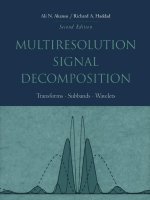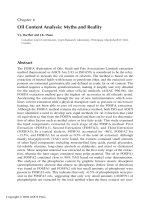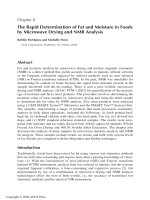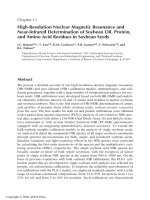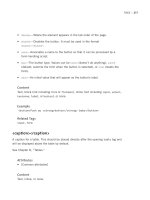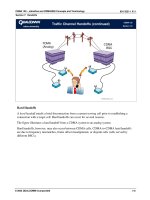Multiresolution Signal Decomposition Transforms, Subbands, and Wavelets phần 8 potx
Bạn đang xem bản rút gọn của tài liệu. Xem và tải ngay bản đầy đủ của tài liệu tại đây (2.39 MB, 47 trang )
J.6.
BLOCK TRANSFORM PACKETS
363
Figure
5.18:
(a)
Mixed tertiary/binary
tree,
(b)
Tiling pattern.
Scaling
Function
Wavelet
Function
Lowpass
PR-QMF
High-Pass
PR-QMF
OT
2
°fl
9
9
°T°to
0\
4
2 2
a
T<i>
rt
°t
"I
°l
Daubechies
0.314
5.22
0.699
0.178
8.97
1.596
0.453
0.987
0.453
0.987
Mostregular
0.143
5.77
0.825
0.188
11.70
2.199
0.470
0.996
0.470
0.996
Coiflet
0.086
11.86
1.02
0.108
39.36
4.25
0.305
1.059
0.305
1.059
Table
5.7:
Time-frequency localizations
of
six-tap
wavelet
niters
and
correspond-
ing
scaling
and
wavelet
functions.
364
CHAPTER
5.
TIME-FREQUENCY
REPRESENTATIONS
5.6.1
Prom Tiling
Pattern
to
Block Transform
Packets
The
plots
of
several orthonormal
8x8
block transforms
are
shown
in
Fig. 2.7.
These depict
the
basis sequences
of
each transform
in
both time-
and
frequency-
domains. These plots demonstrate
that
the
basis
sequences
are
spread
over
all
eight
time slots whereas
the
frequency
plots
are
concentrated over eight separate
frequency
bands.
The
variation
in
these
from
transform
to
transform
is
simply
a
matter
of
degree rather
than
of
kind.
The
resulting
time-frequency
tiling
then
would
have
the
general
pattern
shown
in
Fig.
5.19(a).
There
are
eight time
slots
and
eight
frequency
slots,
and the
energy concentration
is in the
frequency
bands.
The
basis
functions
of
these transforms
are
clearly frequency-selective
and
c«n
be
regarded
as FIR
approximations
to a
"brick wall" (i.e., ideal rectangular
band-pas^
filter)
frequency
pattern
which
of
course would necessitate
infinite
sine
function
time responses.
Figure
5.19:
(a)
Tiling pattern
for
frequency-selective
transform,
(b)
Tiling pattern
for
time-selective transform
The
other extreme
is
that
of the
shifted
Kronecker
delta
sequences
as
basis
functions
as
mentioned
in
Section 2.1.
The
time-
and
frequency-domain plots
are
shown
in
Fig. 5.20. This realizable block transform (i.e.,
the
identity matrix)
has
perfect
resolution
in
time
but no
resolution
in
frequency.
Its
tiling
pattern
is
shown
in
Fig.
5.19(b)
and can be
regarded
as a
realizable
brick-wall-in-time
pattern,
the
dual
of the
rionrealizable
brick-wall-in-frequency.
5.6.
BLOCK TRANSFORM PACKETS
365
Figure 5.20:
(a)
Basis functions
in
time;
(b)
magnitude
of
Fourier transform
of
basis
functions.
The
challenge here
is to
construct
a
specified
but
arbitrary tiling
pattern
while
retaining
the
computational
efficiencies inherent
in
certain
block transforms, using
the
DFT,
DOT.
MET,
and WH. Our
objective then
is to
develop desired time-
localized
patterns starting
from
the
frequency-selective
pattern
of
Fig.
5.19(a),
and
conversely,
to
create frequency-localized tiling
from
the
time-localized
Kronecker
delta
pattern
of
Fig.
5.19(b).
The first
case
is the
time-localizable
block transform,
or
TLBT
(Kwak
and
Haddad, 1994), (Horng
and
Haddad, 1996). This
is a
unitary block transform
which
can
concentrate
the
energy
of its
basis
functions
in
desired time
intervals—
hence,
time-localizable.
We
start
with
a
frequency-selective block transform, viz.,
the
DOT,
DFT,
WH.
whose
basis
functions
behave
as
band-pass sequences,
from
low-pass
to
high-pass.
366
CHAPTER
5.
TIME-FREQ
UENCY
REPRESENTA
TIONS
Figure 5.21: Structure
of the
block transform packet.
as in
Fig. 2.7. Consider
a
subset
of
M&
basis
functions with contiguous frequency
bands.
We
then construct
a new set of
M&
time-localized basis functions
as a
linear combination
of the
original
M&
(frequency-selective) basis functions
in
such
a way
that
each
of the new
M&
basis
functions
is
concentrated over
a
desired
time
interval
but
distributed over
M&
frequency
bands. Hence
we can
swap
frequency
resolution
for
time resolution
in any
desired pattern.
The
construction
of the
TLBT
system
is
shown
in
Fig. 5.21.
Let
0i(n),
i,n
=
0,1,
,7V
—
1, and
ipi(n),
«,n
=
0,1,
,7V
—
1, be the
original
set of
orthonormal
basis sequences,
and the
TLBT basis
functions,
respectively.
These
are
partitioned
into
subsets
by the
TV
x
TV
diagonal block matrix,
where
each
coefficient
matrix
A^
is an
M^xM^
unitary matrix,
and
Y^k-o
^k
—
N-
Consider
the
kth
partition
indicated
by
5.6.
BLOCK TRANSFORM PACKETS
and
let a* be the
iih
row of
A&,
such
that
'0/c,i(
n
)
i
g
^
le
hirier
product
^fc,i(
n
)
=
a*$
fe
(n).
We
want
to find the
coefficient
vector
a^
such
that
the
TLBT basis
sequence
'ipk,i(
n
)
maximally concentrates
its
energy
in the
interval
Ii
:
[i(jf~),
(i
+
l)(']g~)
—
1].
We
choose
to
minimize
the
energy
of
^(n)
outside
the
desired
I
t
,
:
i.e.,
to
minimize
subject
to
orthonormality
constraint
on the
rows
of
Af~,
Q*QJ
—
6i j.
Hence,
we
minimize
the
objective
function
It can be
shown
(Prob.
5.5)
that
the
optimal
coefficient
vector,
a
?
.
is the
eigenvector
of a
matrix
E\
which
depends
only
on
J>
fc
,
where
v^
indicates
the
conjugate
transpose.
We
now
have
a
procedure
for
retiling
the
time-frequency plane
so as to
meet-
any set of
requirements.
Figure 5.22:
(a)
Original tiling
pattern
for
frequency
concentrated
8x8
transform,
(b)
Tiling pattern
for
M
fc
=
1,1,
2,4.
(c)
Tiling
pattern
for
M
k
=
4,1,1,
2.
It
is
noted
that
the
selection
of the
M^
values
determines
the
time-frequency
tiling
patterns.
The
larger
the
value
of
Mfc,
the
more time resolution
can be
368
CHAPTER
5.
TIME-FREQUENCY
REPRESENTATIONS
obtained
at the
cost
of
sacrificing
the
resolution
in
frequency.
For
example,
if
we
use an
8x8
block transform
to
construct
the
time-frequency tiling pattern
in
Fig.
5.22(b),
the
entire
set of
basis
functions should
be
partitioned into
four
subsets with sizes
,M&
=
1,
1,2,4.
For the
time-frequency
tiling
in
Fig.
5.22(c),
the
values
of
Mjt
are
4,1,1,2.
Figure
5.
23
(a)
shows
a
portion
of a
time-
frequency
tiling based
on the 64 x 64
DCT
transform. According
to
Fig.
5.23(a)
the
entire
set of
DCT
basis
functions
is
partitioned
into several subsets:
{<po(n),
,
^>s(n)}
for the
subspace
So
with
MQ
=
4,
{(j>4(n)}
for
Si
with
MI
=
1,
{$s(n)}
for
S
2
with
M
2
= 1,
{$e(n),
$i
3
(n)}
for
5,4
with
A/4 = 8, • • • . For So, the
subset
of the
TLBT basis functions
is
$o(n)
=
|0o(
n
)?
,
'03
(ra)}.
In
Fig.
5.
23
(a),
the
number
on
each cell represents
the
order
of
the
TLBT basis functions. Cells
ZQ
and
Z^
are the
regions where
tyo(n) and
^(ri)
will concentrate their energies.
The
energy distributions
in
both
the
time-
and
frequency-domains
for
0o(?0
and
02
(^)
are
illustrated
in
Figs.
5.23(b)
and
5.23(c),
respectively. These
figures
demonstrate
that
il'o(n)
and
"02
(^)
concentrate
their energies both around
(1-5)(||)
in the
frequency-domain,
but in the
different
time
intervals
[0
—
15] and [32
—
47],
respectively. From
these
figures, we see
that
the
TLBT basis functions concentrate most
of
their energies
in the
desired time
interval
and
frequency
band,
specified
in
Fig.
5.23(a).
The
dual case
is
that
of
constructing
a
frequency-localized transform
FLBT
from
the
time-localized
Kroriecker
delta sequences. Here,
we
select
M of
these
to
be
transformed into
0^,05
•••>'0fe.A/ i
via the
unitary
M x M
matrix
B.
where
We
define
Jj
as the
energy concentration
in the
frequency
domain
in the
iih
frequency
band,
where
^^-(u;)
is the
Fourier transform
of the
basis
function
^/^-(n),
and the
given
frequency
band
is
I
Ui
—
{2m(N/M)
<
LJ
<
[27r(i
+
l)(AT/M)-l]}.
J{
is
maximized
if
we
choose
B to be the DFT
matrix,
i.e
In
other words,
the DFT is the
optimum sequence
to
transform
the
information
from
time-domain
to the
frequency-domain.
Horng
and
Haddad
(1998) describe
a
5.6.
BLOCK TRANSFORM PACKETS
369
Frequency
Figure 5.23:
(a)
Portion
of
desired tiling pattern;
(b)
energy distribution
of
0o(
n
)
in
both time-
and
frequency-domain associated with cell
1 in
(a);
(c)
energy dis-
tribution
of
V'i(ri)
in
both
time-
and
frequency-domain
for
cell
3 in
(a).
370
CHAPTERS.
TIME-FREQUENCY
REPRESENTATIONS
Figure 5.24:
(a)
Time localized Kronecker delta
tiling
pattern;
(b)
Intermediate
pattern;
(c)
Desired tiling pattern.
procedure
for
constructing
a
FLBT
that
matches
a
desired tiling pattern starting
from
the
delta sequences.
The
process involves
a
succession
of
diagonal block
DFT
matrices
separated
by
permutation matrices.
The final
transform
can be
expressed
as
the
product
of a
sequence
of
matrices with
DFT
blocks along
the
diagonal
and
permutation matrices.
In
this procedure,
no
tree formulations
are
needed,
and we
are
able
to
build
a
tiling pattern
that
cannot
be
realized
by
pruning
a
regular
or,
for
that
matter,
an
irregular tree
in the
manner suggested earlier,
as in
Figs. 5.16
and
5.17.
The
procedure
is
illustrated
by the
following
example. Figure
5.24(c)
is the
desired
pattern
for an 8 x 8
transform. Note
that
this
pattern
is not
realizable
by
pruning
a
binary tree,
nor any
uniformly
structured tree
as
reported
in the
papers
by
Herley
et.
al.
(1993).
(1) We
note that Fig.
5.24(c)
is
divided into
two
broad
frequency
bands,
[0,7T/2]
and
[vr/2,
TT];
therefore,
we
split
the
tiling
pattern
of
Fig.
5.24(a)
into
two
bands using
a 2 x 2 DFT
transform matrix. This results
in the
pattern
of
Fig.
5.24(b).
The
output
coefficient
vector
y =
[yQ,yi, yj]
corresponding
to the
input
data vector
/ is
given
by
where
AI
—
diag[<f>2,
$2,
$2»
$2]
and
<!>&
is a k x k DFT
matrix.
The
2x2
DFT
matrix takes
two
successive time samples
and
transforms them
into
two
frequency-domain
coefficients.
Thus
$2
operating
on the first two
time-
domain
samples,
/o and
/]_,
generates transform
coefficients
yo
and
y\,
which
rep-
resent
the
frequency
concentration over
[0,
Tr/2]
and
[?r/2,
TT],
respectively. These
5.6.
BLOCK
TRANSFORM
PACKETS
371
are
represented by
cells
yo?
yi
m
Fig-
5.24(b),
(2) We
apply
a
permutation matrix
P to
regroup
the
coefficients
yi
into same
frequency
bands.
In
this
case,
P
T
—
[<$Q
,
#2
>
$F?
$F?
^T?
^3
•>
&§
•>
^i\i
where
5k
=
[0 ,.,().
1,0,
,0]
is the
Kronecker
delta.
(3)
Next
we
observe
that
the
lower
frequency
band
in
Fig.
5.24(c)
consists
of
two
groups: Group
A has 3
narrow bands
of
width
(?r/6)
each
and
time duration
6
(from
0 to
5),
and
group
B has one
broad band
of
width
(?r/2)
and
duration
2
(from
6 to
7).
This
is
achieved
by
transformation matrix
=
diag\^^i]
applied
to
the
lower
half
of
Fig.
5.24(b).
The top
half
of
Fig.
5.24(c)
is
obtained
by
splitting
the
high-frequency
band
of
Fig.
5.24(b)
from
7T/2
to
TT
into
two
bands
of
width
7T/4
and
time duration
4.
This
is
achieved
by
transformation
matrix
=
diag\<&<2<&<2}
applied
to the top
half
of
Fig.
5.24(b).
Thus,
where
A%
—
diag[3>s,
3>i,
$2,
$2]-
The
final
block
transform
is
then
where
A
=
A$
P
A
2
as
given
in Eq.
(5.55)
and C =
e
j27r
/
3
.
The
basis sequences corresponding
to
cells
ZI,ZQ
are the
corresponding rows
of
the A
matrix. Concentration
of
these sequences
in
both time-
and
frequency-
domains
is
shown
in
Figs. 5.25
and
5.26.
zi(n)
is
concentrated over
first 6
time
slots
as
shown
in the
plot
of
zi(n)\
2
.
The
associated
frequency response
\Zi(e^)
2
is
shown
in
Fig.
5.25(b),
which
is
concentrated
in the
frequency
band
(7T/6,27r/6).
ZQ(H)
is
concentrated over
last
four
time slots
in
Fig.
5.26(a)
and
|Ze(e
:?
'
u;
)|
2
=
sin(o;/2)
—
sin(2o;/2)
2
concentrates over
(37r/4,7r)
as in
Fig.
5.26(b).
372
CHAPTER
5.
TIME-FREQUENCY REPRESENTATIONS
Figure 5.25: Energy distribution
for
cell
Z\\
(a)
time-domain;
(b)
frequency-
domain.
Figure
5.26:
Energy
distribution
for
cell
Z
6
:
(a)
time-domain;
(b)
frequency-
domain.
5.6'.
BLOCK TRANSFORM PACKETS
373
5.6.2 Signal
Decomposition
in
Time-Frequency
Plane
We
have seen
how to
synthesize block transform packets with specified time-
frequency
localization while maintaining
the
computational
efficiency
of the
pro-
genitor transform.
The
next
and
perhaps more challenging problem
is the de-
termination
of the
tiling pattern
that
"best"
portrays
the
time-frequency energy
properties
of a
signal.
To
achieve this goal,
we
will
first
review
the
differing
ways
of
representing continuous time signals,
and
then
work
these into
useful
tiling pat-
terns
for
discrete-time signals.
Our
description
of
classical
time-frequency
distri-
butions
is
necessarily
brief,
and the
reader
is
encouraged
to
read some
of the
cited
literature
for a,
more rigorous
and
detailed treatment (Cohen, 1989, Hlawatsch
and
Bartels,
1992).
The
short-time Fourier transform (STFT)
and the
wavelet transform
are ex-
amples
of
two-dimensional representations
of the
time-frequency
and
time-scale
characteristics
of a
signal. Accordingly, these
are
often
called spectrograms,
and
scalograms, respectively.
The
classical
time-frequency
distribution tries
to
describe
how
the
energy
in a
signal
is
distributed
in the
time-frequency
plane.
These
dis-
tributions
P(t,
0),
then,
are
functions
structured
to
represent
the
energy variation
over
the
time-frequency
plane.
The
most
famous
of
these
is the
Wigner
(or
Wigner-Ville)
(Wigner, 1932;
Ville.
1948) distribution
for
continuous-time signals.
This
distribution,
W(£,Q)
represents
the
energy density
at
time
t and
frequency
H,
and
W(t,
Q)A£AQ
is the
fractional
energy
in the
time-frequency cell
AtAQ,
at the
point
(t,
O).
It is
defined
and
the
total
energy
Using
x(t]
<->
X(Q)
as a
Fourier transform
pair,
this
distibution
can
also
be
expressed
as
This classical
function
has the
following
properties:
(1) It
satisfies
the
marginals, i.e.,
374
CHAPTER
5.
TIME-FREQUENCY REPRESENTATIONS
where
\x(t)\
2
and
|Jf(O)|
2
are
instantaneous
energy
per
unit,
time
and per
unit
frequency,
respectively.
(2)
W(t,ti)
-
W*(t,ty,
i.e.,
it is
real.
(3)
Support properties:
If
x(t)
is
strictly time-limited
to
[£1,^2],
then
W(t,i
I)
is
also time-limited
to
[^1,^2]-
By
duality,
a
similar statement holds
in the
frequency
domain.
(4)
Inversion formula
states
that
W(t,£l)
determines
x(t)
within
a
multiplicative
constant,
While
the
foregoing distribution
has a
very nice Fourier-like properties,
it
never-
theless
suffers
from
the
following disadvantages:
(1) It is
computationally burdensome
for the
discrete-time case
to be
considered
subsequently.
(2)
W(t.£l)
can
take
on
negative values,
which
is
inappropriate
for an
"energy"
function.
(3) The
Wigner distribution
is not
zero
at
intervals where
the
time
function
x(t)
(or
frequency function
X(£l)
is
zero.
(4) It has
spurious terms
or
artifacts.
For
example,
the
Wigner distribution
for the
sum
of two
sine waves
at
frequencies
QI,
02
has
sharp
peaks
at
these
frequencies,
but
also
a
spurious
term
at
(Oi
+
$72/2).
The
Choi-Williams
(1989) distribution
ameliorates such artifacts
by
modifying
the
kernel
of the
Wigner distribution.
Still
other
time-frequency
energy distributions have been proposed,
two
exam-
ples
of
which
are the
positive density
function,
(5)
Time
and
frequency
shifts:
If
x(t]
«-»
W
xx
(t,
O),
then
5.6.
BLOCK TRANSFORM PACKETS
375
and the
complex-valued
Kirkwood (1933) density
Each
of
these satisfies
the
marginals
and has
some advantages over
the
Wigner
form,
primarily ease
of
computation.
The
discrete time-frequency version
of
these
distributions
has
been examined
in
the
literature (Peyrin
and
Prost,
1986),
arid
various
forms
have
been
advanced.
The
simplest Wigner
form
is
where
L
is the DFT
length. When derived
from
continuous time signals, sampling
and
aliasing considerations come into play. Details
can be
found
in the
literature.
In
particular,
see
Peyrin
and
Prost
(1986).
A
discrete version
of the
Kirkwood distribution
is the
real
part
of
where
x(n)
<-»
X(k)
are a DFT
pair
and
[$(fc,n)]
=
[e?
2
*
kn
/
N
]
is the DFT
matrix.
This
last
P(n,
k)
satisfies
the
marginals
and
For the
tiling study,
and for
ease
of
computation,
we
define
the
quasi-distribu-
tion
with
the
properties
376
CHAPTER
5.
TIME-FREQUENCY REPRESENTATIONS
For our
computational purposes,
we
choose
the
X(k)
to be the
DCT, rather
than
the
DFT,
as our
tiling measure. Therefore,
for our
purposes,
we
define
the
time-frequency
energy metric
as the
normalized product
of
instantaneous
energy
in
each domain,
where
C
normalizes
Y^
n
^k^(
n
^)
=
^-
^
n
^
le
nex
*
section,
the
P(n,k]
of
Eq.
(5.69)
is
called
a
"microcell,"
and the
distribution
of
these microcells
de-
fines
the
energy distribution
in the
time-frequency plane.
The
tiling
pattern
as
discussed
in the
next section consists
of the
rank-ordered partitioning
of the
plane
into clusters
of
microcells, each
of
which constitutes
a
resolution cell
as
described
in
Section
5.6.1.
5.6.3 From Signal
to
Optimum Tiling
Pattern
We
have seen
how to
construct block transform packets with
specified
time-
frequency
localization
while
maintaining
the
computational
efficiency
of the
pro-
genitor
transform.
The
next question
is
what kind
of
tiling pattern should
we use to fit the
sig-
nal
characteristics?
A
resolution
cell
is a
rectangle
of
constant area
and a
given
location
in the
time-frequency
plane.
The
tiling
pattern
is the
partitioning
of the
time-frequency
plane into contiguous resolution cells. This
is a
feasible
partition-
ing.
Associated with each resolution cell
is a
basis
function
or
"atom." Each
coefficient
in the
expansion
of the
signal
in
question using
the new
transform
basis
function
represents
the
signal strength associated with
that
resolution
cell.
We
want
to find the
tiling
pattern
corresponding
to the
maximum energy concentra-
tion
for
that
particular signal. From
an
energy compaction point
of
view,
the
tiling
pattern should
be
chosen such that
the
energies concentrate
in as few
coefficients
as
possible.
In
order
to
answer this question,
we
need
to
define
an
appropriate time-
frequency
energy distribution which
can be
rapidly computed
from
the
given
sig-
nal
.
Microcell
Approach
The
Kronecker delta sequence resolves
the
time-domain information,
and the
frequency-selective
block
transforms provide
the
frequency
information. Combin-
ing
these
two
characterizations together gives
the
energy sampling grid
in the
time-frequency
plane.
Let Xi =
|/(z)|
2
,
the
amplitude square
of the
function
/(?"),
5.6.
BLOCK TRANSFORM PACKETS
877
0
<
i
<
A
r
—
1,
at
time
ij
and
yj
—
\F(j)
2
the
magnitude square
of the
coeffi-
cient
of the
frequency-selective block transform
(e.g.,
DCT)
at
frequency
slot
/;.
Take outer product
of
these
two
groups
of
samples
to
obtain
the
quasi distribu-
tion.
Eq.
(5.69),
Pij
=
XiUj,
i,j
=
0,1, ,JV
—
1.
Each
P(i,j]
represents
the
energy
strength
in the
corresponding area
in the
time-frequency plane.
The
area
corresponding
to
each
P(i,j)
is
called
a
microcell.
P
=
P(z,
j)
is the
microcell
energy
pattern
or
distribution
for a
given signal. Totally
we
have
N
2
microcells
and
each resolution cell
is
composed
of N
microcells. Take
N = 8 as an
example:
We
have
64
microcells
and
each resolution cell consists
of 8
microcells arranged
in
a
rectangular
pattern
1 x 8. 2 x 4, 4 x 2, and
8x1.
Therefore,
our
task here
is
to
group
the
microcells such
that
the
tiling pattern
has the
maximum energy
concentration.
Search
for the
Most Energetic Resolution Cell
The
most energetic
resolution
cell
in P is the
rectangular region which
is
corn-
posed
of N
microcells
and has the
maximum energy strength.
Our
objective
is
to
search
P —
{P(i,j)},
the
pattern
of
TV
2
energy microcells
in the T-F
plane,
to
find
the
feasible
pattern
of N
resolution cells
Zj,
0
<
i
<
N —
1,
such
that
the
signal energy
is
optimally concentrated
in as few
cells
as
possible.
We can
perform
an
exhaustive search
of P
using rectangular windows
of
size
N to find
the
most energetic resolution cell,
and
then
the
second most energetic resolution
cell,
and so on.
With some assumptions,
we can
improve
the
search
efficiency
as
fellow's.
Assume
that
the
most energetic microcell
P*(z,
j)
is
included
in the
most
energetic resolution cell
Z*.
We
search
the
neighborhood
of
P*(«,
j) to find the
rectangular cluster
of N
microcells with
the
most energy.
That
cluster defines
the
most energetic resolution cell
Z*.
Therefore, starting
from
the
most energetic
microcell.
we
group
the
microcells
to find the
most energetic resolution
cell.
The
procedure
is as
follows:
(1)
Rank order
P(i,
j),
and
P^,
i =
1,
JV
2
are the
rank-ordered microcells.
(2)
Form
the
smallest rectangle
A\
specified
by
PI
and P2. We
test
if
these
can be
included
in one
resolution cell
by
simply calculating
the
area
of
A\.
\\A-\\
,
\Ai
\
<
N. If
not,
test
PI
and
P
3
.
(3)
Form
the
smallest rectangle
A%
specified
by
A\
and
next available
P,,
and
repeat
the
test.
(4)
Repeat
forming
rectangles
and
tests
until
|
Ai
ast
=
N.
Ai
ast
is the
most
energetic resolution cell
Z*.
378
CHAPTER
5.
TIME-FREQUENCY
REPRESENTATIONS
Repeat this search
for the
next most energetic resolution cell. Eventually,
a
complete
T-F
tiling
pattern
can be
obtained. This procedure
is
tedious
and not
practical
for
large transforms.
In the
following,
we
describe
a
more
efficient
way,
a
sequentially adaptive approach.
Adaptive
Approach
The
objective
of the
proposed method
is to
expand
our
signal
in
terms
of
BTP
basis
functions
in a
sequential fashion,
i.e.,
find one
resolution cell
from
a
succession
of N T-F
tiling
patterns
rather
than
N
cells
from
one T-F
pattern.
The
concept
of
matching pursuit (Mallat
and
Zhang,
1993),
as
embodied
in
Fig. 5.27,
suggests
the
following
adaptive scheme:
(1)
Start
at
stage
q =
1.
We
construct
PI
from
/(n)
and use the
microcell
and
search
algorithm
to find the
most energetic resolution
cell
Z\
with
its
associated
basis
function
ipi(n)
and
block transform packet
T\.
The
projection
of
/(»)
onto
ipi
(n)
gives
the
coefficient
fa
arid
our first
approximation
(2)
Take
the
residual
/i(n)
as the
input
to the
next
stage
where
(3)
Repeat
(1) and (2) for q
>
1
where
the
residual
signal
fi(n)
at
ith
stage
is
and
ifri(n)
is the
most energetic basis
function
corresponding
to
tiling pattern
PI
and BTP
T,
L
.
In
general,
the
basis
functions
ifii(n)
need
not be
orthonormal
to
each other.
However,
at
each
stage
the BTP is a
unitary transform
and
therefore,
|
/(n)|j
>
||/i(n)|
and j
/J_I(TI)||
>
||/i(n)||.
Thus
the
norm
of the
residual
fi(n)
monotoni-
cally
decreases
and
converges
to
zero. Similar
to the
matching pursuit algorithm,
this
procedure maintains
the
energy conservation property.
Because this representation
is
adaptive,
it
will
be
generally concentrated
in a
very
small subspace.
As a
result,
we can use a finite
summation
to
approximate
the
signal with
a
residual error
as
small
as one
wishes.
The
approximated
signal
can be
expressed
as
5.6.
BLOCK TRANSFORM PACKETS
379
Figure 5.27:
Block
diagram
of
adaptive
BTP-based
decomposition algorithm.
380
CHAPTER
5.
TIME-FREQUENCY
REPRESENTATIONS
The
error energy
for
that
frame
using
L
coefficients
is
For
a
long-length signal, this scheme
can be
adapted
from
frame
to
frame.
5.6.4
Signal Compaction
In
this section,
two
examples
are
given
to
show
the
energy concentration properties
of
the
adaptive BTP.
The BTP is
constructed
from
DCT
bases with block size
32.
In
each example
the
signal length
is
1024 samples.
The
data
sequence
is
partitioned into
32
frames
consisting
of 32
samples
per
frame.
For
each
frame,
we
compute
the
residual
fi(n)
and the
corresponding error energy
f^,
1
<
i
<
4. The
average
of
these
O^'s
over
32
frames
is
then plotted
for
each example
to
show
the
compression
efficiency.
For
comparison purpose,
the
standard
DCT
codec
is
also
used.
Figure
5.28(a)
shows
the
energy concentration property
in
terms
of the
number
of
coefficients
for BTP and DCT
codecs.
The
testing signal
is a
narrow band
Gaussian signal
Si
with
bandwidth^
0.2 rad and
central frequency
5?r/6.
Because
of
the
frequency-localized nature
of
this signal,
BTP has
only slight compaction
improvement over
the
DCT.
The
signal used
in
Fig.
5.28(b)
is the
narrow-band
Gaussian signal
Si
plus time-localized white Gaussian noise
$2
with
10%
duty
cycle
and
power ratio
(81/82)
=
—8dB.
Basically,
it is a
combination
of
frequency-
localized
and
time-localized signals
and
therefore,
it
cannot
be
resolved only
in
the
time-
or in the
frequency-domain.
As
expected,
BTP
shows
the
compaction
superiority
over
DCT in
Fig.
5.28(b).
It
demonstrates that
BTP is a
more
efficient
and
robust compaction engine over DCT.
It is
noted
that
the BTP
codec, like
any
adaptive tree codec, needs some side
information
for
decompression. They
are the
starting point
and
size
of the
post
matrix
Ak in Eq.
(5.45),
and the
location
of the
most energetic
coefficient
which
defines
the
location
and
shape
of the
most energetic resolution tile.
If one
uses
the
adaptive approach, side information
is
necessary
at
each stage. Therefore,
the
compression
efficiency
will
be
reduced significantly.
One
possible solution
is to
use one
tiling
pattern
for
each
frame
of
data.
Another possible solution
is to use
the same BTP basis functions for adjacent frames of
data.
Both will reduce the
side-information
effect
and
improve
the
compression
efficiency.
5.6.
BLOCK TRANSFORM
PACKETS
381
Figure
5.28:
Compaction
efficiency
comparisons
for (a)
narrow-band
Gaussian
signal
5i,
(b)
Si
plus time localized Gaussian signal
52
with
power
ratio
Si/Sz
=
-8dB.
382
CHAPTERS.
TIME-FREQUENCY REPRESENTATIONS
5.6.5
Interference Excision
Spread spectrum communication systems provide
a
degree
of
interference rejection
capability. However,
if the
level
of
interference becomes
too
great,
the
system will
not
function
properly.
In
some cases,
the
interference immunity
can be
improved
significantly
using signal processing techniques which complement
the
spread
spec-
trum modulation
(Milsteiri,
1988).
The
most commonly used type
of
spread spectrum
is the
direct sequence spread
spectrum
(DSSS),
as
shown
in
Fig. 5.29,
in
which
modulation
is
achieved
by
superimposing
a
pseudo-noise
(PN) sequence upon
the
data
bits. During
the
transmission,
the
channel adds
the
noise term
n and an
interference
j_.
Therefore,
the
received signal
/ can be
written
as
where
the
desired signal
s
=
dc
is the
product
of
data
bit
stream
d and the
spread-
ing
sequence
c.
In
general,
n is
assumed
to be
additive white Gaussian noise with
parameter
7V"o
and j
could
be the
narrow-band
or
time-localized
Gaussian
inter-
ference.
In the
absence
of
jammers,
both
the
additive white Gaussian noise
n
and
PN
modulated sequence
s are
uniformly
spread
out in
both time
and
fre-
quency domains. Because
of the
presence
of the
jamming signal,
the
spectrum
of
the
received signal
will
not be flat in the
time-frequency plane.
The
conventional
fixed
transform
based excisers
map the
received signal into frequency bins
and
reject
the
terms with power
greater
than
some threshold.
This
system works
well
if
the
jammers
are
stationary
and
frequency
localized.
In
most cases jamming
signals
are
time-varying
and not
frequency concentrated.
Furthermore,
the
dis-
crete wavelet transform bases
are not
adapted
to
represent functions whose Fourier
transforms
have
a
narrow high frequency support (Medley
et
al.,
1994). There-
fore,
conventional transform-domain based techniques perform poorly
in
excising
nonstationary
interference such
as
spikes (Tazebay
and
Akansu,
1995).
Adaptive
BTPs
provide arbitrary
T-F
resolutions
and are
suitable
for
dealing
with such problems.
The
energetic resolution cells indicate
the
location
of the
jamming signal
in the T-F
plane;
this
jamming signal
can be
extracted
from
the
received signal
by
using
adaptive
BTP
based techniques. Figure 5.27 shows
the
adaptive scheme
for
multistage interference excision.
(1)
In the first
stage,
q =
1,
we
construct
BTP
T\
for a
frame
of the
received
signal
/
by
using
the
microcell
and
search algorithm
and find the
basis
function
4'i(
n
)
an(
i
coefficient
(3\
associated with
the
most energetic cell.
(2) If the
interference
is
present (the time-frequency spectrum
is not flat as
determined
by
comparison
of the
most energetic cell with
a
threshold based
on
5.6.
BLOCK
TRANSFORM
PACKETS
383
Figure 5.29: Block diagram
of a
DSSS communication system.
average
of
energy
in all
other
cells),
take
the
residual
/i(n)
as the
input
to the
next stage
as in Eq.
(5.71).
(3)
Repeat
(1) and (2) for q > 1
where
the
residual signal
fi(n)
at
zth
stage
as in Eq.
(5.72)
and
ipi(n]
is the
most energetic basis
function
corresponding
to
BTP
TI.
(4)
Stop
this
process
at any
stage
where
the
spectrum
of the
residual signal
at
that
stage
is flat.
The
performance
of the
proposed ABTP exciser
is
compared with
DFT and
DCT
excisers.
A
32-chip
PN
code
is
used
to
spread
the
input
bit
stream.
The
resulting
DSSS signal
is
transmitted over
an
AWGN
channel.
Two
types
of
inter-
ference
are
considered:
a
narrow-band jammer with
uniformly
distributed random
phase
(Q €
[0,2?r]),
and a
pulsed
(time-localized)
wide-band
Gaussian
jammer.
Figure
5.30(a)
displays
the bit
error rate (BER) performance
of the
ABTP exciser
along with
DFT and DCT
based excisers
for the
narrow-band jammer case where
the
signal
to
interference power ratio (SIR)
is
—15
dB. The
jamming signal
j can
be
expressed
as
where
UJQ
=
7r/2
and 0 € [0,
2?r].
Three largest bins
are
removed
for DFT
arid
DCT
based excisers. Because
of the
frequency
concentrated nature
of the
jam-
ming signal,
all
systems
perform comparably. Figure
5.30(b)
shows
the
results
for a
time-localized wideband Gaussian jammer.
The
jammer
is an
on/off
type
that
is
randomly switched with
a 10%
duty cycle.
In
this scenario,
as
expected,
none
of the fixed-transform-based
excisers
is
effective
for
interference suppression.
However,
the
ABTP exciser
has
significant improvement over
the fixed
transform
based exciser.
The
ABTP exciser also
has
consistent performance
at
several other
SIR
values.
384
CHAPTERS.
TIME-FREQUENCY
REPRESENTATIONS
It
should
be
noted
that
neither
the
duty cycle
nor the
switching
time
of the
interference
is
known
a
priori
in
this scheme.
The
ABTP exciser performs slightly
better
than
the DCT
exciser
for the
single tone interference,
but is far
superior
to the DCT and DFT for any
combination
of
time-localized wide-band Gaussian
jammers
or
time-localized
single-tone
interference.
The
excision problem
is
revisited
in
Section 7.2.2
from
the
standpoint
of
adap-
tive
pruning
of a
subband
tree structure.
A
smart
time-frequency
exciser (STFE)
that
is
domain-switchable
is
presented.
Its
superior performance over existing
techniques
is
presented
arid
interpreted
from
the
time-frequency perspective.
5.6.6
Summary
Traditional Fourier analysis views
the
signal over
its
entire extent
in
time
or in
frequency.
It is
clearly inadequate
for
dealing with signals with
nonstationary
characteristics.
The
STFT,
the
wavelet transform,
and the
block transform packet
are
analysis techniques which
can
extract signal features
in the
time-frequency
plane.
In
this chapter,
we
compared
the
localization properties
of
standard
block
transforms
and filter
banks
from
this vantage point.
The
time-frequency approach described
in
this chapter sets
the
stage
for
inno-
vative
and
adaptive methods
to
deal with "problem" signals, some
of
which
are
described here,
and
others outlined
in
Chapter
7.
(Figure
on
facing page)
Bit
error
rate
(BER) performance
for
adaptive
BTP ex-
ciser:
(a) BER for
narrow-band interference,
SIR
—
—15 dB, (b) BER for
time-
localized
wide-band Gaussian jammer,
10%
duty cycle,
and SIR
=
—15
dB.
5,6.
BLOCK TRANSFORM PACKETS
385
Figure 5.30
386
CHAPTER
5.
TIME-FREQUENCY
REPRESENTATIONS
References
A.
N.
Akansu,
"Multiplierless
Suboptimal
PR-QMF
Design,
55
Proc.
SPIE
Vi-
sual Communication
and
Image Processing,
pp. 723
734, Nov. 1992.
A.
N.
Akansu,
R. A.
Haddad
and H.
Caglar,
"The
Binomial
QMF-Wavelet
Transform
for
Multiresolution
Signal Decomposition," IEEE Trans. Signal Pro-
cessing,
Vol.
41,
No. 1, pp.
13-19,
Jan. 1993.
A.
N.
Akansu
and Y.
Liu,
"On
Signal Decomposition Techniques." Optical
Engineering,
pp.
912-920,
July 1991.
A.
N.
Akansu,
R. A.
Haddad
and H.
Caglar, "Perfect Reconstruction Bino-
mial
QMF-Wavelet
Transform," Proc.
SPIE
Visual Communication
and
Image
Processing,
Vol. 1360,
pp.
609-618,
Oct. 1990.
J. B.
Allen
and L. R.
R,abiner,
"A
Unified
Approach
to
Short-Time Fourier
Analysis
and
Synthesis," Proc. IEEE, Vol.
65, pp.
1558-1564,
1977.
M.
J.
Bastiaans,
"Gabor's
Signal Expansion
and
Degrees
of
Freedom
of
a
Signal,"
Proc, IEEE, Vol.
68, pp.
538-539,
1980.
R. B.
Blacknian
and J. W.
Tukey,
The
Measurement
of
Power
Spectra.
Dover,
1958.
B.
Boashash
and A.
Riley,
"Algorithms
for
Time-Frequency
Signal Analysis,"
in
B.
Boashash,
Ed.,
Time-Frequency
Signal Analysis. Longman, 1992.
G.
F.
Boudreaux-Bartels
and T. W.
Parks,
"Time-Varying
Filtering
and
Signal
Estimation
Using Wigner Distribution Synthesis Techniques,"
IEEE
Trans. ASSP,
Vol.
ASSP-34,
pp.
442-451,
1986.
H.
Caglar,
Y. Liu and A. N.
Akansu, "Statistically Optimized PR-QMF
De-
sign,"
Proc. SPIE Visual Communication
and
Image Processing, Vol. 1605,
pp.
86-94,
1991.
L.
C.
Calvez
and P.
Vilbe,
"On the
Uncertainty Principle
in
Discrete Signals,"
IEEE
Trans.
Circ.
Syst II:
Analog
and
Digital Signal Processing, Vol.
39, No. 6,
pp.
394-395,
June 1992.
D. C.
Champeney,
A
Handbook
of
Fourier
Transforms.
Cambridge University
Press, 1987.
H.
I.
Choi
and W. J.
Williams, "Improved Time-Frequency Representation
of
Multicomponent
Signals Using Exponential Kernels,"
IEEE
Trans.
ASSP,
Vol.
ASSP-37,
1989.
T. A. C. M.
Claasen
and W. F. G.
Mecklenbrauker, "The Wigner
Distribution-
A
Tool
for
Time-Frequency Signal Analysis;
Part
I:
Continuous-Time Signals."
Philips
J.
Res.,
Vol.
35, pp.
217-250,
1980.
5.6.
BLOCK
TRANSFORM
PACKETS
387
T. A.
C.
M.
Claasen
and W. F. G.
Mecklenbrauker,
"The Wigner
Distribution-
A
Tool
for
Time-Frequency Signal Analysis;
Part
II:
Discrete-Time Signals," Philips
,1.
Res.,
Vol.
35, pp.
276-300,
1980.
L.
Cohen, "Generalized Phase-Spaced Distribution Functions,"
J.
Math.
Phys.,
Vol.
7, pp.
781-806,
1966.
L.
Cohen,
"Time
Frequency
Distributions-
A
Review,"
Proc.
of
IEEE,
Vol.
77.
No.
7, pp. 941
981, July 1989.
R.
Coifman
and Y.
Meyer,
"The Discrete Wavelet Transform," Technical
Re-
port, Dept.
of
Math.,
Yale Univ., 1990.
R.
Coifman
and Y.
Meyer,
"Orthonormal
Wave Packet Bases," Technical
Re-
port, Dept.
of
Math.,
Yale
Univ.,
1990.
J. M.
Combes,
A.
Grossman,
and P. H.
Tchamitchian,
Eds.,
Time-Frequency
Methods
and
Phase
Space.
Springer, 1989.
R. E.
Crochiere
and L. R.
Rabiner,
Multirate
Digital Signal Processing. Pren-
tice-Hall, 1983.
I.
Daubechies,
"Orthonormal
Bases
of
Compactly
Supported
Wavelets," Com-
munications
in
Pure
and
Applied
Math.,
Vol.
41, pp.
909-996,
1988.
I.
Daubechies, "The Wavelet Transform, Time-Frequency Localization
and
Sig-
nal
Analysis," IEEE Trans.
Information
Theory, Vol.
36, No. 5, pp.
961-1005,
Sept.
1990.
I.
Daubechies,
A.
Grossmann,
and Y.
Meyer,
"Painless Nonorthogonal
Expan-
sions,"
J.
Math.
Phys.,
Vol.
27, No. 5, pp.
1271-1283,
1986.
J. B. J.
Fourier,
"Theorie
Analytique
de la
Chaleur,"
in
Oeuvres
de
Fourier,
tome premier,
G.
Darboux,
ed.
Gauthiers-Villars,
1888.
D.
Gabor,
"Theory
of
Communications,"
J. of the IEE
(London), Vol.
93, pp.
429-457,
1946.
J.
Gevargiz,
P. K.
Das,
and L. B.
Milstein, "Adaptive Narrowband Interference
Rejection
in a DS
Spread Spectrum Intercept Receiver Using Transform Signal
Processing Techniques," IEEE Trans. Communications, Vol.
37, No. 12. pp.
1359-
1366, Dec. 1989.
R. A.
Haddad,
A. N.
Akansu
and A.
Benyassine, "Time-Frequency Localization
in
Transforms,
Subbands
and
Wavelets:
A
Critical review," Optical Engineering,
Vol.
32, No. 7, pp.
1411-1429,
July
1993.
C.
Herley,
J.
Kovacevic,
K.
Ramchandran,
and M.
Vetterli, "Tilings
of the
Time-Frequency Plane: Construction
of
Arbitrary Orthogonal Bases
and
Fast
